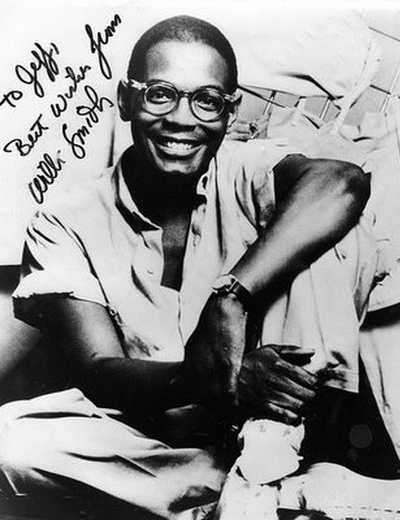
Willi Donnell Smith
About
Willi Donnell Smith was one of the most successful African-American fashion designers in fashion history. At the time of his death, his company Williwear Ltd. sold $25 million worth of clothing a year.
Willi Smith was born in Philadelphia, Pennsylvania, USA in 1948.
As a boy Smith spent a lot of time drawing with his mother, and he nurtured dreams of becoming an artist. After his parents were divorced, his grandmother, Gladys Bush, became an important figure in motivating Smith to pursue his artistic interests. She defended her grandson when he missed family curfews because of lingering too long at the Philadelphia Museum of Art or when he spent untold hours sitting on the floor sketching. While studying fashion illustration at the Philadelphia Museum College of Art in 1964, Smith began developing a greater interest in clothing design.
In 1967, Smith quit Parsons to pursue a career designing on his own. In 1969 he designed a label for Digits, a sportswear company. In 1973, Smith, along with his sister Toukie Smith, founded their own clothing company that soon failed.
He graduated in 1968 and became a freelance knitwear designer. He worked for New York designer Arnold Scaasi in the mid-1970's.
In 1976, he opened WilliWear, his Sportswear company. He said that he wanted to plug the gap between Jeans and stiff evening wear.
The following winter Smith's collection generated only about $30,000 of business, but one of Smith's pants designs became extremely popular. Characteristic of what would become the Willi Smith look, the pants were a baggy fatigue with a high, wrapped waist and became known as the "WilliWear pant."
Before long the streetwise and sassy WilliWear designs caught the public's attention in a big way, and other designers soon copied the style. Smith's next collection sold $200,000; by 1982 WilliWear had an annual gross topping $5 million. In 1978 Smith introduced WilliWear Men, a line of clothes that incorporated both formality and casualness.
Smith worked with many other designers and artists during his time at Williwear including Anthony Mark Hankins, James Mischka, Julia Santos-Solomon, Jon Coffelt, John Bartlett and Andre Walker among many others. Smith partnered with Jhane Barnes on some of his earlier shows.
In 1983, Willi Smith won the coveted Coty Award.
Willi was a good friend of the singer Madonna in the 1980's and she still remembers him affectionately.
In 1985, he created the uniforms worn by workings draping the Pont Neuf for Christo's artwork. In 1987 he designed the clothes worn at the wedding of Caroline Kennedy, President Kennedy's daughter.
Several young designers worked with Willi, one of whom in 1986 was Anthony Mark Hankins, an African-American Texan designer, now coming into prominence. James Mischka (partner in Badgley-Mischka design house) worked under Willi Smith from 1985 to 1986. John Bartlett took over the design when Willi Smith died, and remained till 1990.
Willi Smith died of complications of AIDS in 1987. At that time it was a relatively unknown disease and there was no cure. People with a gay lifestyle were most at risk till the 1990's when the medical profession understood AIDS better. Smith, who was openly gay, has a panel in the original NAMES Project AIDS Memorial Quilt and is also lamented in a poem "Speak: A Poem for the Millennium March by Keith Boykin, read by its author for the Millennium March on Washington for Equality on April 29, 2000.
His company continued to function after his death, opening it's first store in New York on Fifth Avenue in 1988.
In 2000-2002, the city of New York decided to honour American fashion designers by placing bronze plaques along 7th Avenue, the great street of fashion in New York. This has been called the "FASHION WALK OF FAME." Willi Smith was one of those honoured.
Many of his garments are nowadays found on vintage clothing outlets, on the net and in shops. They are quite popular. On the right is a cotton padded three quarter length warm coat with toggle buttons, from the mid-1980's, on sale today. It has his trademark graffiti print on the inside.
The Look
His oversized clothing anticipated the casual styles and attitudes of the following decades: baggy trousers and shorts, slouchy sweaters and generously proportioned shirts. Nowadays the rap style is almost identical to the designs which he started in the 1970's and 1980's. His colours and fabrics were bright and easily mixed together. Willi Smith's moderately priced clothes tended to be exuberant and youthful. He made slouchy blazers, long full dirndle skirts, oversize shirts, dhoti pants and tank tops. His evening clothes were peppy such as pouf-skirted dresses with slits as high as the waist, or with racing-back necklines. His sister Tookie Smith, born in 1954, is an actress. She had twin boys by a surrogate. She had a relationship with actor Robert de Niro for some time. Perhaps in part due to his Indian cottons and colors, or to his inexhaustible appeal to youth, or maybe just due to his own wit and sense of loose fit, Smith excelled in clothing for summer. His winter collections, too, were especially notable for oversized coats based on classic shapes. His WilliWear News for fall 1986 proclaimed with irony his intention to get "serious" with the fall collection. In a sense, Smith never was serious, preferring instead a lively incongruity he had learned from observation and refined from affordable clothing made in India. His soft, baggy looks did not require sophisticated tailoring and benefitted from the Indian textiles that he chose for their supple hand, easy care and comfortable aging, and indescribably indefinite colors. Smith's slouchy softness was a "real people" look, marketed at modest costs with great impact in the 1980s as the informality of designer jeans and other casual wear was replaced by the kind of alternative Smith's designs offered—a drapey silhouette for comfortable clothing with style.
Who Wears It
Caroline Kennedy, Madonna, Mary Jane Watson, Edwin Schlossberg